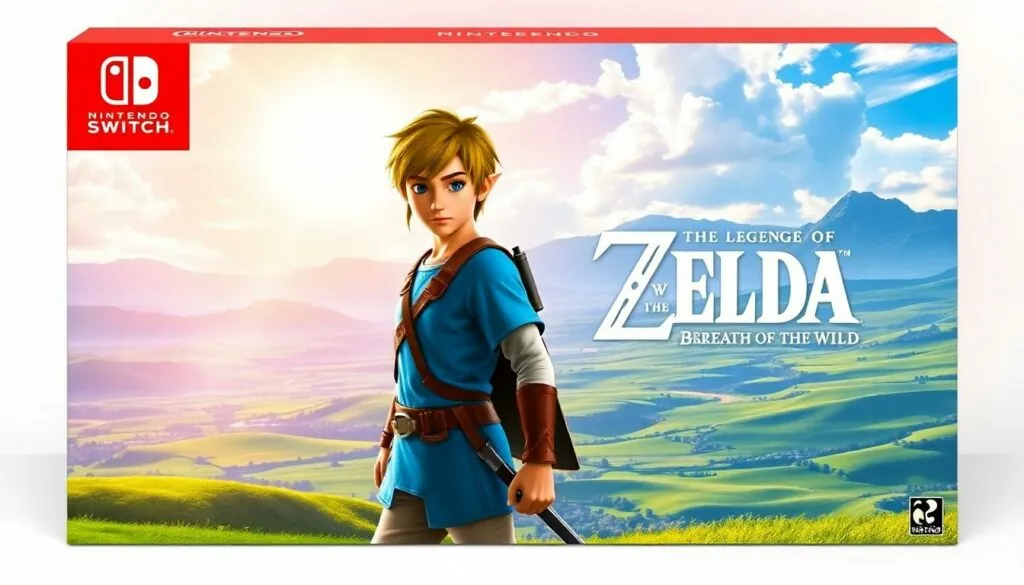In a world where epic quests and heroic adventures reign supreme, The Legend of Zelda: Breath of the Wild stands out as a shining beacon of gaming excellence. But let’s be honest—what’s a legendary game without its equally legendary box art? This stunning visual masterpiece isn’t just a pretty face; it’s a gateway into Hyrule’s vast landscapes and thrilling escapades.
Table of Contents
ToggleOverview of The Legend of Zelda Breath of the Wild
“The Legend of Zelda: Breath of the Wild” stands as a groundbreaking title within the gaming industry. This action-adventure game, developed by Nintendo, debuted alongside the Nintendo Switch in March 2017. Players explore the vast open world of Hyrule, filled with diverse landscapes and dynamic ecosystems.
Game mechanics encourage experimentation and exploration. Players utilize a variety of weapons, tools, and abilities to navigate challenges. Physics-based gameplay enables unique problem-solving opportunities, enhancing player engagement. Side quests enrich the narrative, providing depth and character development.
Visual design captivates audiences with stunning graphics. The vibrant art style blends anime influences with realistic landscapes. Box art reflects this aesthetic, showcasing the protagonist, Link, against the backdrop of Hyrule’s expansive beauty. This imagery draws players into the adventure awaiting inside.
Critical reception highlights this game as a milestone in game design. Awards acknowledge its innovative open-world mechanics and immersive storytelling. Game reviewers praise its freedom of exploration and player agency, setting new standards for future titles within the genre.
Cultural impact extends beyond gameplay. Merchandise, fan art, and creative adaptations celebrate Hyrule’s universe and characters. The box art serves as an emblem of the game’s success, inviting players to embark on unforgettable journeys. Each element contributes to “Breath of the Wild” being a landmark in gaming history.
The Significance of Box Art in Gaming
Box art plays a crucial role in the gaming experience, acting as a visual invitation into immersive worlds like Hyrule. The artwork not only captures attention but also encapsulates the essence of the game.
Visual Appeal and Marketing
The box art for “The Legend of Zelda: Breath of the Wild” stands out due to its striking visuals. Featuring Link against breathtaking backgrounds, it draws players in with vibrant colors and detailed design. This artwork serves as an essential marketing tool, enticing potential customers and sparking interest. The blend of anime influences and realism showcases the game’s artistic direction effectively, making it memorable. Designers understand that a compelling cover can elevate a game’s market presence, creating anticipation for what lies beyond the box. Ultimately, it reinforces the game’s innovative reputation and promises excitement.
Representation of Game Themes
Themes of exploration and adventure are central to “Breath of the Wild,” and the box art reflects this narrative. Link’s pose, coupled with a vast landscape, symbolizes freedom and discovery within Hyrule’s expansive world. Each element on the cover hints at the various experiences players encounter, from solving puzzles to battling foes. Artistic choices communicate the essence of the game, highlighting the journey players undertake. Symbols of nature and vastness emerge in the design, aligning with the game’s core mechanics. Consequently, the box art becomes a representation of the extraordinary adventure awaiting players.
Breakdown of the Nintendo Switch Box Art
The Nintendo Switch box art for “The Legend of Zelda: Breath of the Wild” features captivating designs that effectively represent the game’s core themes. Eye-catching visuals dominate the front cover, drawing attention to Link amidst the stunning landscapes of Hyrule. Diverse colors enhance the appeal, showcasing the vibrancy and depth of the game’s art style. Link’s dynamic pose indicates movement, symbolizing adventure and exploration. Art elements reflect the game’s innovative mechanics, inviting players to immerse themselves fully in this open world.
Front Cover Design Elements
Front cover elements highlight standout features of the game. Link appears prominently, showcasing his determination and courage. The background portrays breathtaking environments, hinting at the expansive world players can explore. Iconic symbols related to the game’s lore enhance the allure, creating intrigue about the gameplay experience. Colors blend harmoniously, combining both fantasy and realism, which captivates potential players. Each detail on the cover serves to communicate the essence of the adventure awaiting inside.
Comparisons to Other Box Art Versions
Nintendo’s box art for “The Legend of Zelda: Breath of the Wild” significantly differs from previous entries in the series. Competing versions emphasize more vibrant colors, reflecting the game’s expansive landscapes and intricate details. The aesthetic choices in the Nintendo Switch version highlight Link’s adventure while embodying the rich lore of the franchise.
Comparative analyses reveal a trend toward minimalist designs in modern releases. The emphasis on clean lines and focused character imagery resonates with gamers and denotes sophistication. While earlier titles often cluttered the cover with additional characters and elements, Breath of the Wild prioritizes Link as the central figure against a backdrop of Hyrule’s sweeping vistas.
The PlayStation 4 and Xbox One box art designs often feature dynamic characters in action poses, but Breath of the Wild opts for a more serene representation. This contrast highlights the game’s exploration aspect, setting it apart both visually and thematically. Cover art for similar adventure games frequently hints at combat, whereas Breath of the Wild emphasizes discovery and freedom.
Japanese box art often showcases unique stylistic elements that differ from Western designs. Typically, the Japanese release brings detailed illustrations, while Western versions lean towards simplicity for mass appeal. This contrast underlines cultural influences shaping design choices across regions.
Specific elements, such as the iconic Master Sword or the Sheikah Eye symbol, repeatedly connect with the game’s lore on various box art versions. Link’s pose and expression in the Switch edition indicate both determination and curiosity, which resonate well with the intended audience. Each box art version serves its purpose, drawing players in and encapsulating the spirit of the game.
Conclusion
The box art for “The Legend of Zelda: Breath of the Wild” serves as a powerful representation of the game’s essence. Its striking visuals not only attract potential players but also encapsulate the spirit of exploration and adventure that defines Hyrule. By prioritizing Link against breathtaking landscapes, the artwork invites gamers into a world brimming with possibilities.
This minimalist approach marks a significant shift from previous titles, focusing on the core themes of freedom and discovery. As a symbol of the game’s cultural impact, the box art continues to resonate with fans, sparking interest and inspiring creativity. Overall, it stands as a testament to the innovative legacy of “Breath of the Wild” within the gaming landscape.




